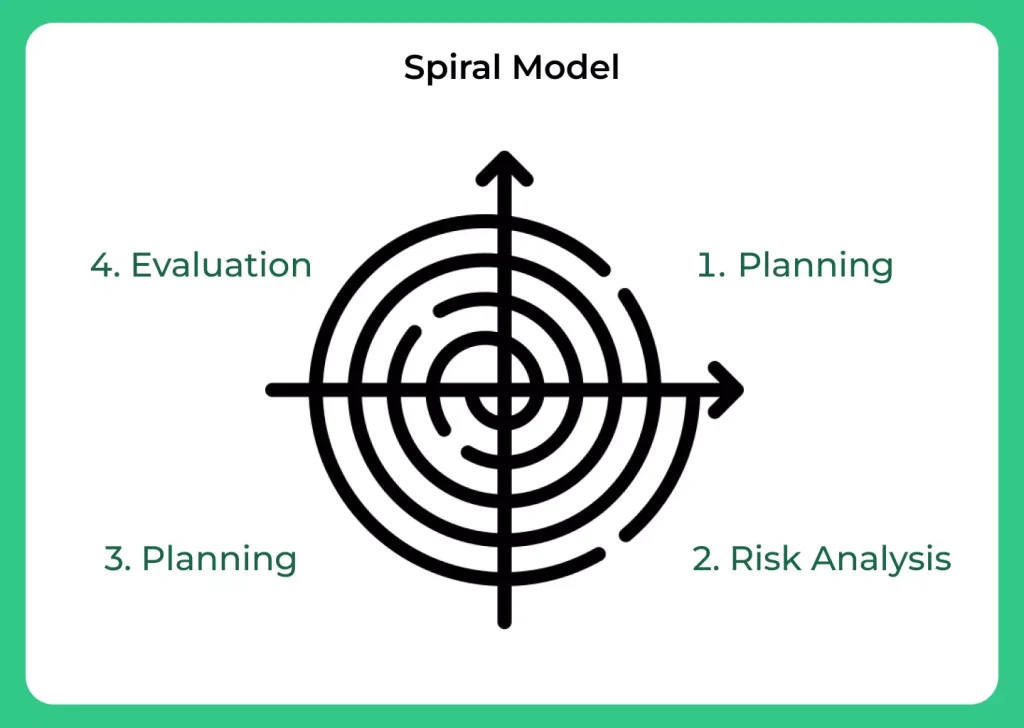Spiral Model in SDLC
Spiral Model in SDLC
The Spiral Model in SDLC is a software development approach that combines the best features of both iterative and waterfall models. It allows teams to develop software in a series of cycles, or “spirals,” where each spiral involves planning, risk assessment, development, and testing. This model is beneficial because it focuses on early identification and reduction of risks, allowing for flexibility and continuous improvement throughout the project.
The Spiral Model is ideal for large, complex projects where risks are uncertain, as it enables developers to refine requirements and solutions with each iteration, leading to a more robust final product.

What is Spiral Model in SDLC?
The Spiral Model is a software development life cycle (SDLC) model that is used to develop software through a series of incremental releases. It is an evolutionary approach that involves iteratively developing, testing, and refining the software in successive cycles, or “spirals.”
Overall, the Spiral Model is a useful approach for managing complex software development projects, but it requires a high level of discipline and careful planning to be effective.
Outline
Different Processes in Spiral Model in SDLC
The Spiral model is often used in complex projects where the requirements are not fully understood at the beginning of the project, or where the project involves a high level of risk. It is also often used in projects that require frequent interaction with stakeholders or that involve the development of custom software.
The Spiral model consists of the following phases:

Planning:
In this phase, the project team defines the goals and objectives of the project, and develops a plan for achieving them. This may involve gathering requirements from stakeholders, identifying risks and developing risk-mitigation strategies, and estimating the resources and budget required for the project.
Risk assessment:
In this phase, the project team assesses the risks associated with the project and develops strategies to mitigate those risks. This may involve conducting a thorough analysis of the project, identifying potential problem areas, and developing contingency plans to deal with those problems if they arise.
Engineering:
In this phase, the project team begins the actual development of the software. This may involve writing code, building prototypes, and conducting testing and debugging.
Review and evaluation:
In this phase, the project team reviews the progress of the project and evaluates the results of the engineering phase. This may involve conducting user acceptance testing, gathering feedback from stakeholders, and making any necessary modifications to the software.
Planning for the next iteration:
After completing the review and evaluation phase, the project team begins planning for the next iteration of the Spiral model. This may involve revising the project plan, reassessing risks, and making any necessary adjustments to the project.
Risk Handling in Spiral Model
Risk handling in the Spiral Model is a key part of its process. Here’s how it works:
- Risk Identification: At the start of each cycle, potential risks, like technical challenges or project delays, are identified.
- Risk Analysis: Once risks are identified, they are carefully analyzed to understand their possible impact on the project.
- Risk Mitigation: Strategies are then developed to reduce or eliminate these risks, such as creating backup plans or testing new technologies early.
- Prototyping: To manage high-risk areas, small prototypes may be developed. This helps in understanding how certain aspects will work and minimizes the risk of major failures later on.
- Continuous Monitoring: Throughout the project, risks are constantly monitored, and the plan is adjusted as needed to address new or evolving risks.
This approach helps ensure that risks are managed effectively, leading to a more successful project.
The Spiral Model in SDLC is referred to as a Meta Model. Why?
The Spiral Model is often called a “Meta Model” because of the following reasons:
- Combination of Models: The Spiral Model integrates features from other software development models like the Waterfall and Iterative models. It combines these approaches into a single framework, making it more comprehensive.
- Flexible Structure: It provides a structure that can be adapted to different project needs. Teams can tailor the Spiral Model to suit specific project requirements, making it versatile.
- Higher-Level View: The Spiral Model focuses on the overall process of software development, including risk management and continuous improvement, rather than just following a fixed sequence of steps.
- Iterative and Incremental: It supports repeated cycles of development, allowing for constant refinement, which is a key aspect of a meta-model that manages the entire process.
This is why the Spiral Model is referred to as a Meta Model.
Advantages and Disadvantages of Spiral Model in SDLC
Advantages:
The spiral model is a software development lifecycle (SDLC) model that is used to create and manage software projects. It is a risk-driven process that combines elements of both the waterfall model and the incremental model. The main advantages of the spiral model are:
Risk Management:
The Spiral Model emphasizes early identification and mitigation of risks through iterative cycles. This reduces the chances of project failure by addressing potential issues early.
Flexibility:
Its iterative nature allows changes to be made at any stage of development. This makes it adaptable to evolving requirements or feedback.
Early Feedback:
Frequent prototypes and reviews ensure early feedback from stakeholders. This helps align the final product with user expectations.
Suitable for Large Complex Projects:
The Spiral Model is ideal for large, high risk projects with complex requirements. Its structured phases help manage complexity while allowing progressive development.

Disadvantages:
Complexity:
The spiral model can be complex and difficult to understand, especially for those unfamiliar with it. It requires a detailed understanding of the project and its risks, as well as a clear plan for managing and mitigating those risks.
Time and cost:
The spiral model can be time-consuming and costly, as it involves multiple iterations and evaluations. This can be a disadvantage for projects with tight budgets or deadlines.
Communication:
The spiral model requires effective communication and coordination among all team members, as well as with the client. Poor communication can lead to misunderstandings and delays.
Change management:
The spiral model is based on the idea of continuous change and evolution, which can be challenging to manage. It requires a flexible approach to change management and a willingness to adapt to new requirements and challenges as they arise.
Suitability:
The spiral model may not be suitable for all projects. It is best suited for projects that involve high levels of risk and uncertainty, as well as projects that require a high degree of interaction with the client. It may not be appropriate for smaller or simpler projects.
When to use Spiral Model in SDLC?
The Spiral Model is useful in the following situations:
- Large Projects: Use it for complex and large projects where requirements may change over time. Its iterative nature helps manage complexity.
- Unclear Requirements: When project requirements are not fully understood or are expected to evolve, the Spiral Model allows for adjustments through each cycle.
- High Risk: If the project involves high risks or new technology, the model helps identify and address risks early, reducing the chance of major issues later.
- Continuous Feedback: Ideal when regular feedback from stakeholders is needed. The model’s iterative cycles ensure that feedback is integrated into the development process.
- Incremental Delivery: Use it if you need to deliver the project in parts. The model supports gradual development and testing of each component.
To wrap it up:
In conclusion, the Spiral Model in SDLC offers a flexible and risk-managed approach to software development. Its iterative cycles allow for continuous refinement and adaptation, making it ideal for complex projects with evolving requirements.
By focusing on regular feedback and risk assessment, the Spiral Model helps ensure that the final product meets user needs and reduces the likelihood of major issues, leading to more successful and durable software outcomes.
FAQ's
The Spiral Model is designed to identify and address risks early in each iteration. However, if a new risk arises mid-development, it is assessed during the current or next spiral’s Risk Analysis phase. Mitigation strategies are then incorporated before moving forward, which ensures risk control is continuous and adaptive—not one-time.
Yes, the Spiral Model can be blended with Agile principles. Agile teams can treat each spiral loop as a sprint, focusing on delivering working increments with a strong emphasis on risk assessment and stakeholder feedback. This hybrid approach helps Agile teams manage uncertainty in large-scale or high-stakes projects.
Skipping a spiral loop is not recommended, even if risks appear low. Each loop adds refinement and validation to the project. Instead of skipping, the loop can be shortened or simplified to maintain the structured risk-check process without unnecessary delay.
The model’s iterative nature allows teams to reassess tools, platforms, or technologies at each spiral. If a better or more efficient technology emerges, it can be evaluated for risks and benefits, and then integrated into future spirals with minimal disruption.
Get over 200+ course One Subscription
Courses like AI/ML, Cloud Computing, Ethical Hacking, C, C++, Java, Python, DSA (All Languages), Competitive Coding (All Languages), TCS, Infosys, Wipro, Amazon, DBMS, SQL and others



